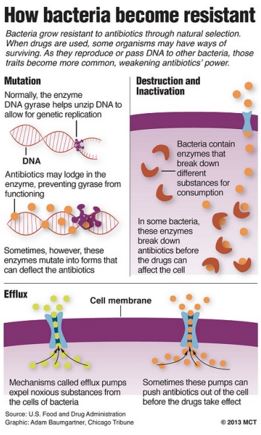Antibiotic threat
Resistance may prove devastating in future

The increasing antibiotic resistance has raised alarm around the globe. A recent superbug at the Dunedin Hospital in New Zealand has been identified as an antibiotic-resistant infection. To help prevent the spread of resistance, use good hygiene, cook meat thoroughly, and only use antibiotics when necessary.
You are sick or injured. When you go to the doctor, they may prescribe you with antibiotics to aid you with your ailment.
However, there have been growing concerns about the overuse of antibiotics, which has been linked to an alarming emergence of drug-resistant bacterial strains over the past few decades.
Director general of World Health Organization (WHO) Margaret Chan told The Albany Daily Star, “The world is heading toward a post-antibiotics era in which common infections will once again kill.”
“If current trends continue, sophisticated interventions like organ transplantation, joint replacement, cancer chemotherapy and care of preterm infants will become more difficult or even too dangerous to undertake.”
According to the Centers for Disease Control (CDC), two million Americans are diagnosed with drug-resistant infections every year. These are infections that do not respond to ordinary antibiotic treatments and require much stronger drugs.
One such example is the carbapenem-resistant Enterobacteriaceae (CRE). In 2001, only one state in the U.S. reported CRE infections – North Carolina. 14 years later, 48 states reported CRE infections to the CDC.
And antibiotic breakthroughs have slowed, with only nine new antibiotics approved in the last decade, a stark contrast to the 29 discovered in the 1980s.
How did this all start?
Antibiotic resistance is a result of evolution.
Bacteria reproduce so often that they acquire various genetic mutations, either modifying their binding sites (so the drug can no longer enter the membrane) or reduce the accumulation of the drug within the bacteria (by pumping the drug out).
These “surviving” bacteria then continue to reproduce.
All of a sudden, instead of killing off the bacteria, the antibiotic has given rise to a mass number of new genetically-mutated bacteria that are more difficult to kill. To sum it up, it is survival of the fittest.
The reason behind the rising occurrences of antibacterial resistance is the overuse of antibiotics and antimicrobial chemicals in the modern lifestyle. It is also spread through the use of antibiotics in industrial farming.
According to a meta-analysis published by the Proceedings of the National Academy of Sciences (PNAS), the global use of antibiotic drugs increased by 36 percent from 2000 to 2010.
Harshini Mukundan, a microbiologist at Los Alamos National Laboratory, told Huffington Post, “We need to be very careful in using antimicrobial agents for everything from hand washing to toothpaste.”
Mukundan and her colleagues have been tracking the emergence of drug-resistant strains in high disease burden populations where antibiotic resistance is a major concern.
The team is working to develop new tests for a faster diagnosis of drug-resistant infections in collaboration with the Los Alamos National Laboratory metagenomics group and Los Alamos scientists Ben McMahon and Norman Doggett.
To combat antibiotic resistance, the CDC has released recommendations for patients and healthcare providers to follow. Among them include only taking the antibiotics that the doctor prescribes and not asking the doctor for antibiotics that s/he thinks is unnecessary.
There are smart choices that can be made at home as well. The Food and Drug Administration (FDA) recently released in a report that there is no evidence showing antibacterial soaps as better at preventing infections compared to ordinary soap.
Instead they stated that, “New data suggest that the risks associated with long-term, daily use of antibacterial soaps may outweigh the benefits.”
The U.S. government is working to inhibit the spread of antibiotic resistance as well.
Your donation will support the student journalists of Sycamore High School. Your contribution will allow us to purchase equipment and cover our annual website hosting costs.









